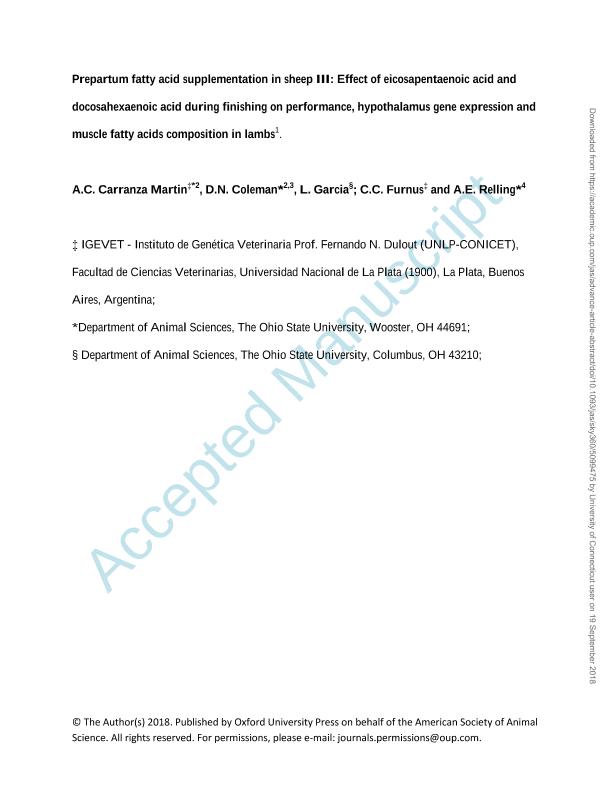Artículo
Prepartum fatty acid supplementation in sheep. III. Effect of eicosapentaenoic acid and docosahexaenoic acid during finishing on performance, hypothalamus gene expression, and muscle fatty acids composition in lambs
Carranza Martin, Ana Cristina ; Coleman, Danielle Nicole; Garcia, Lyda Guadalupe; Furnus, Cecilia Cristina
; Coleman, Danielle Nicole; Garcia, Lyda Guadalupe; Furnus, Cecilia Cristina ; Relling, Alejandro Enrique
; Relling, Alejandro Enrique
 ; Coleman, Danielle Nicole; Garcia, Lyda Guadalupe; Furnus, Cecilia Cristina
; Coleman, Danielle Nicole; Garcia, Lyda Guadalupe; Furnus, Cecilia Cristina ; Relling, Alejandro Enrique
; Relling, Alejandro Enrique
Fecha de publicación:
12/2018
Editorial:
American Society of Animal Science
Revista:
Journal of Animal Science
ISSN:
0021-8812
Idioma:
Inglés
Tipo de recurso:
Artículo publicado
Clasificación temática:
Resumen
The objectives of this study were to evaluate the effect of feeding an enriched diet with eicosapentaenoic acid (EPA) and docosahexaenoic acid (DHA) to finishing lambs born from ewes supplemented either with or without EPA and DHA during late gestation on productive performance, muscle fatty acid (FA), and hypothalamus mRNA concentration of metabolic genes and hormone receptors. Lambs born from dams fed during the last 50 d of gestation either with a control diet containing 0.39% Ca salts of palmitic fatty acid distillate (C) or Ca salts enriched with EPA and DHA (PFA) were used. After weaning lambs (n = 70) were blocked by weight (BW) and used in a 2 × 2 factorial into 2 finishing diets containing 1.5% of C or PFA. The 2 factors were the ewe diet and the finishing diet. Lambs (37.9 ± 0.4 kg) were weighed and blood sampled for glucose and NEFA measurements at days 1, 14, 28, and 42. Dry matter intake (DMI) was measured daily. At day 43, 14 females and 14 males were slaughtered, and hot carcass weight, body wall thickness, rib eye area, and FA composition of Longissumus thoracis muscle were evaluated. Female hypothalamuses were obtained and mRNA concentration of hormone receptors, neuropeptides, and their receptors was measured. Lambs born from PFA dams were heavier (P < 0.01). There was a time × finishing diet interaction for BW (P = 0.03), and lambs fed C had a greater BW. Lambs fed C had an increase in DMI (P < 0.01). There were no significant differences in plasma glucose and NEFA concentration (P > 0.1). Lambs born from PFA dams had a greater concentration of C22:0 (P < 0.03). Lambs fed C had higher concentrations of C18:1c15 (P < 0.01), C17:0 (P < 0.09), C18:0 (P < 0.09), and n6/n3 (P < 0.01). Lambs fed PFA had greater concentration (P < 0.05) of C16:1, C22:1, C20:5, C22:5, C22:6, total n3 FA, and total EPA and DHA. There was a significant dam × finishing diet interaction (P ≤ 0.08) on mRNA concentration for MCR3, CCK-R, Cort-R, and CART. Lambs, which had the same treatment as their dams, showed lower overall mRNA concentration than those with different treatments between them and their dams. Lambs born from PFA ewes had lower concentration of MCR4 mRNA (P = 0.09) than C. Agouti-related peptides mRNA concentration was lower in lambs fed PFA (P = 0.06) than C. In conclusion, changes on lamb performance, muscle fatty acid composition, and metabolic neuropeptides depend not only on the lamb diet, but also on the dam diet during late gestation.
Palabras clave:
FETAL PROGRAMMING
,
GESTATION
,
OMEGA-3 FATTY ACIDS
Archivos asociados
Licencia
Identificadores
Colecciones
Articulos(IGEVET)
Articulos de INST.DE GENETICA VET ING FERNANDO NOEL DULOUT
Articulos de INST.DE GENETICA VET ING FERNANDO NOEL DULOUT
Citación
Carranza Martin, Ana Cristina; Coleman, Danielle Nicole; Garcia, Lyda Guadalupe; Furnus, Cecilia Cristina; Relling, Alejandro Enrique; Prepartum fatty acid supplementation in sheep. III. Effect of eicosapentaenoic acid and docosahexaenoic acid during finishing on performance, hypothalamus gene expression, and muscle fatty acids composition in lambs; American Society of Animal Science; Journal of Animal Science; 96; 12; 12-2018; 5300-5310
Compartir
Altmétricas



